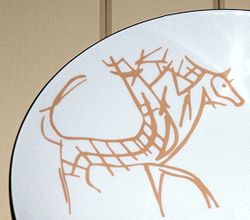
Skien animal
Encyclopedia

Skien
' is a city and municipality in Telemark county, Norway. It is part of the traditional region of Grenland. The administrative centre of the municipality is the city of Skien. Skien is also the administrative centre of Telemark county....
, Norway
Norway
Norway , officially the Kingdom of Norway, is a Nordic unitary constitutional monarchy whose territory comprises the western portion of the Scandinavian Peninsula, Jan Mayen, and the Arctic archipelago of Svalbard and Bouvet Island. Norway has a total area of and a population of about 4.9 million...
, in 1979. It is carved into a plank, and is dated to the 9th century. This, and other findings, shows that Skien
Skien
' is a city and municipality in Telemark county, Norway. It is part of the traditional region of Grenland. The administrative centre of the municipality is the city of Skien. Skien is also the administrative centre of Telemark county....
was a trading centre from before year 1000, and Skien
Skien
' is a city and municipality in Telemark county, Norway. It is part of the traditional region of Grenland. The administrative centre of the municipality is the city of Skien. Skien is also the administrative centre of Telemark county....
was therefore celebrating it’s 1000 year jubilee in the year 2000.
The Skien animal has three heads, one looking backwards, one looking to the side and one looking forward. One possible interpretation of this symbol is that one should both focus on our history (backwards), at the present (sideways), and into the future (forward).

